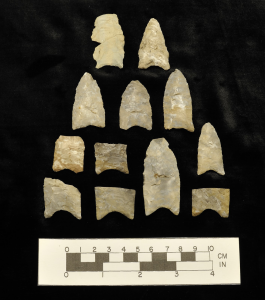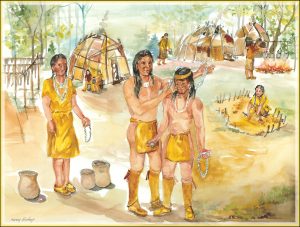Over 10,000 years ago, in the Paleoindian Period, small groups of ancient Native Americans were roaming an American landscape, very different from the one we know today. Massive glaciers extended all the way down to northern Pennsylvania and the climate in the Michaux State Forest was much colder and dryer, but was warming gradually.
The Native Americans of this time roamed vast territories, within which they followed the migrations of the animals that they ate, such as massive mammals (called megafauna), like the mastodon and the giant sloth. However, smaller game was a more important resource in the Camp Michaux region and migrated following seasonal plants.
Paleoindians used a variety of carefully crafted stone tools for a multitude of purposes. Groups were very selective in their tool-making materials, preferring volcanic rock, which is abundant in the Camp Michaux region.

Projectile points collected from the Shoop Archaeological Site in Dauphin County, Pennsylvania, dating back to the Paleoindian Period. Photo courtesy of the State Museum of Pennsylvania, via http://statemuseumpa.org/dauphin-county-projectile-point-collection-ice-age/
The Archaic Period was a time of great environmental change, and serves as a long transition between the Paleoindian and Woodland periods. Lasting between 10,000 and 5000 years ago, the Archaic Period saw the environment become closer to what we know today, as our current geological period, the Holocene, began. This environmental shift allowed for the expansion of plant growth and animal and human development. Camp Michaux would have seen large growth in the forests and a rise in the abundance and variety of small game, making it a very favorable place to inhabit.
Generally, during this time the lifestyle of Native Americans did not change very much. They remained mobile hunter-gatherers until the very end of the period. However, with the end of the last Ice Age, megafauna became extinct because of a combination of the climatic shift and hunting by the Native Americans. Diets shifted to include more small game, but more importantly people began to rely on fishing and harvesting shellfish to support their diets along with seeds and nuts. However, culturally, there was one important development. It is during the Archaic Period we see the first evidence of long distance trade of food, stone tools, and decorative ornaments.
Stone tool technology, also, did not see any large or dramatic changes. Rather, there were small improvements, like the attachment of stone points to sticks using notches at the bottom of spearheads.
With the transition from the Archaic to the Woodland Period, the climate in the Camp Michaux area was what we see today. In the earlier portions of this period, Native Americans, in the Eastern Woodlands relied primarily on the abundance of natural resources and cultivation of crops such as little barley, maygrass, and knotweed. Later, this cultivation intensified and the Native groups became dependent on domesticated crops like corn, beans, and squash. Eventually, as gathering decreased in prevalence, they began to settle down into villages. The population of these villages increased significantly over time, and features, such as storage pits, developed. Pottery also developed significantly during this time and ceramic styles became increasingly more complex and elaborate.

Reproduction of a Native American village during the Late Woodland Period depicting the daily lifestyles of the villagers. Photo courtesy of Pennsylvania Historical and Museum Commision via http://www.phmc.state.pa.us/portal/communities/archaeology/native-american/late-woodland-period.html
Camp Michaux is a promising candidate for a pre-contact Native American site. It is located in a river valley, as many of these sites are, and is rich in the types of materials that were used to create stone tools. The site is located in an area that would have been ideal for small game hunting and gathering. However, there is still much to be uncovered about the potential Native American inhabitants of Camp Michaux. So far, their culture, social structure, and ways of acquiring food are still speculative. Our main questions pertaining to this period are:
- Why were they there? Based on previously studied settlement patterns, we know that most Native Americans inhabited valley areas, either for temporary or permanent camps. This site could have been utilized in a number of ways, including, hunting, gathering, quarrying, or as a place to bed down for the night.
- What did they eat? There were a variety of edible natural resources in the Camp Michaux area, such as, nuts, fruits, small game, and fish. Also, over the thousands of years before European contact, Native American diets shifted based on changes in climate, technology, and agriculture.
- How did the lives of Native Americans change between each period? While we do know how the environment changed over time, we have less evidence of how these changes impacted the daily lives of native populations at Camp Michaux.
Things such as stone tools, animal remains, charred plants, and stone structures could help us answer our questions and provide further insights into the lives of Precolonial Native Americans at Camp Michaux. Due to the ancient and under-researched nature of this site and time, any find, large or small, would prove exciting and informative!
If you would like to learn more about the history and pre-history of Native Americans in Pennsylvania, we recommend these sources:
Carr, Kurt W. and Roger W. Moeller
2015 First Pennsylvanians: The Archaeology of Native Americans in Pennsylvania. Pennsylvania Historical and Museum Commission, Harrisburg, Pennsylvania.
https://www.amazon.com/First-Pennsylvanians-Archaeology-Americans-Pennsylvania/dp/0892711507
History Channel
2009 Native American Cultures. Electronic Document, https://www.history.com/topics/native-american-history/native-american-cultures, Accessed March 22, 2018.
Pennsylvania Historical and Museum Commission
2015 Timelines. Electronic Document
http://www.phmc.state.pa.us/portal/communities/archaeology/native-american/time-periods.html, Accessed March 22, 2018.
Penn State Public Broadcasting
Paleoindian Period in Pennsylvania. Electronic Document
http://pspb.org/archaeology/media/Paleoindian%20Period-Textv3.pdf, Accessed March 22, 2018.
National Park Service
2018 Pre-Contact. Electronic Document,
https://www.nps.gov/cajo/learn/historyculture/pre-contact.htm, Accessed March 22, 2018.
Created by: Cecilia Brine, Sophia Miretskiy, and Ethan Rao-Cramer